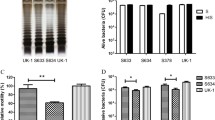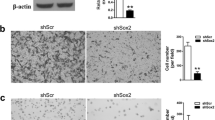Abstract
Objective
The aim of the study was to construct a stable strain of recombined attenuated Salmonella typhimurium expressing NK4 gene, and observe the effect of the strain on the metastatic potentiality of HepG2 cells.
Methods
The NK4 cDNA was isolated from PCAGGS/hNK4 plasmid by PCR, and subcloned into eukaryotic expression vector pcDNA4. The recombinant plasmid was electro-transferred into attenuated Salmonella typhimurium Ty21a to obtain the recombinant strain encoding NK4 gene (TPN). Simultaneously, the recombinant attenuated Salmonella typhimurium carrying GFP gene (TPG) was also constructed. After the TPG and TPN were transferred into HepG2 cells, the transfection rate and the expression level of NK4 protein were detected by flow cytometry and ELISA, and the effects of expression product on the proliferation and migration of HepG2 and angiogenesis were observed.
Results
The TPN and TPG were successfully constructed. Fortyeight hours after transfection with TPG, the infection rate was 82.58% ± 1.74%, and the expression level of NK4 protein in supernatant was (181.5 ± 11.7) ng/6 × 105 cells. The supernatant had obviously depressant effect on the proliferative activity of HepG2 cells (P < 0.05), and could obviously restrain the hepatocyte growth factor-mediated migration of tumor cells (P < 0.01). The inhibitory effect of the expression product on the tumor angiopoiesis was obviously observed (P < 0.05), without a dosage-effect relation.
Conclusion
The TPN could effectively transfer tumor cells in vitro and express interest NK4 protein. The expression product could effectively inhibit the proliferation and migration of hepatocellular carcinoma cells and the tumor angiopoiesis.
Similar content being viewed by others
References
Matsumoto K, Nakamura T. Hepatocyte growth factor (HGF) as a tissue organizer for organogenesis and regeneration. Biochem Biophys Res Commun, 1997, 239: 639–644.
Birchmeier C, Gherardi E. Developmental roles of HGF/SF and its receptor, the c-Met tyrosine kinase. Trends Cell Biol, 1998, 8: 404–410.
Vande Woude GF, Jeffers M, Cortner J, et al. Met-HGF/SF: tumorigenesis, invasion and metastasis. Ciba Found Symp, 1997, 212: 119–130.
Jiang W, Hiscox S, Matsumoto K, et al. Hepatocyte growth factor/scatter factor, its molecular, cellular and clinical implications in cancer. Crit Rev Oncol Hematol, 1999, 29: 209–248.
Matsumoto K, Nakamura T. NK4 (HGF-antagonist/angiogenesis inhibitor) in cancer biology and therapeutics. Cancer Sci, 2003, 94: 321–327.
Date K, Matsumoto K, Shimura H, et al. HGF/NK4 is a specific antagonist for pleiotrophic actions of hepatocyte growth factor. FEBS Lett, 1997, 420: 1–6.
Xin L, Xu R, Zhang Q, et al. Kringle 1 of human hepatocyte growth factor inhibits bovine aortic endothelial cell proliferation stimulated by basic fibroblast growth factor and causes cell apoptosis. Biochem Biophys Res Commun, 2000, 277: 186–190.
Kuba K, Matsumoto K, Ohnishi K, et al. Kringle 1–4 of hepatocyte growth factor inhibits proliferation and migration of human microvascular endothelial cells. Biochem Biophys Res Commun, 2000, 279: 846–852.
Buhles A, Collins SA, van Pijkeren JP, et al. Anti-metastatic effects of viral and non-viral mediated Nk4 delivery to tumours. Genet Vaccines Ther, 2009, 7: 5.
Bermudes D, Zheng LM, King IC. Live bacteria as anticancer agents and tumor-selective protein delivery vectors. Curr Opin Drug Discov Devel, 2002, 5: 194–199.
Jain KK. Use of bacteria as anticancer agents. Expert Opin Biol Ther, 2001, 1: 291–300.
Ryan RM, Green J, Williams PJ, et al. Bacterial delivery of a novel cytolysin to hypoxic areas of solid tumors. Gene Ther, 2009, 16: 329–339.
Tanaka NG, Sakamoto N, Tohgo A, et al. Inhibitory effects of antiangiogenic agents on neovascularization and growth of the chorioallantoic membrane (CAM). The possibility of a new CAM assay for angiogenesis inhibition. Exp Pathol, 1986, 30: 143–150.
Date K, Matsumoto K, Kuba K, et al. Inhibition of tumor growth and invasion by a four-kringle antagonist (HGF/NK4) for hepatocyte growth factor. Oncogene, 1998, 17: 3045–3054.
Kuba K, Matsumoto K, Date K, et al. HGF/NK4, a four-kringle antagonist of hepatocyte growth factor, is an angiogenesis inhibitor that suppresses tumor growth and metastasis in mice. Cancer Res, 2000, 60: 6737–6743.
Sznol M, Lin SL, Bermudes D, et al. Use of preferentially replicating bacteria for the treatment of cancer. J Clin Invest, 2000, 105: 1027–1030.
Bermudes D, Zheng LM, King IC. Live bacteria as anticancer agents and tumor-selective protein delivery vectors. Curr Opin Drug Discov Devel, 2002, 5: 194–199.
Cunningham C, Nemunaitis J. A phase I trial of genetically modified Salmonella typhimurium expressing cytosine deaminase (TAPETCD, VNP20029) administered by intratumoral injection in combination with 5-fluorocytosine for patients with advanced or metastatic cancer. Protocol no: CL-017. Version: April 9, 2001. Hum Gene Ther, 2001, 12: 1594–1596.
Rosenberg SA, Spiess PJ, Kleiner DE. Antitumor effects in mice of the intravenous injection of attenuated Salmonella typhimurium. J Immunother, 2002, 25: 218–225.
Author information
Authors and Affiliations
Corresponding author
Additional information
Both authors contributed equally to this work.
Supported by a grant from the National Natural Science Foundation of China (No. 30772572), two research grants from Postdoctors in China (No. 20060390192, 200801243), a grant from Natural Science Foundation of Gansu Province (No. 0803RJZA061), and a research grant for science from Gansu Provincial Sci. & Tech. Department (No. 0708NKCA128).
Rights and permissions
About this article
Cite this article
Ha, X., Fan, R., Lv, T. et al. Biological effect of NK4 gene mediated by attenuated Salmonella typhimurium on hepatocellular carcinoma cell HepG2. Chin. -Ger. J. Clin. Oncol. 8, 688–693 (2009). https://doi.org/10.1007/s10330-009-0115-6
Received:
Revised:
Accepted:
Published:
Issue Date:
DOI: https://doi.org/10.1007/s10330-009-0115-6




